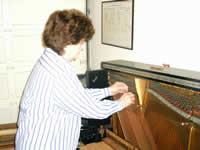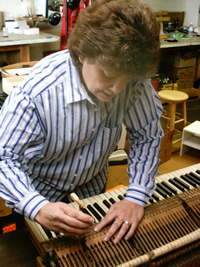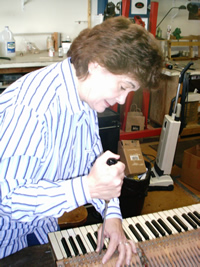- Appraisals
- Tuning
- Pitch Raise
- Repairs
- Regulating
- Voicing
- Reconditioning
- Refurbishing
- Restringing
- Rebuilding
- Troubleshooting
- Damp Chaser Humidity Control Systems
- New Parts
- Pedals
- Consultations and Evaluations
Appraisals: If you are planning to sell or insure your piano, you will need an accurate assessment of its fair market value or its replacement cost. A written appraisal will take into account an evaluation of the piano's qualities as a musical instrument, the condition of its case, and an estimate of any needed repairs.
TopTuning: A combination of aural (tuning by ear) and state-of-the-art electronic tuning helps achieve the most stable and precise tuning for each piano. Manufacturers recommend 2-4 tunings per year. Concert pianos require tuning immediately before each performance.
It is important to note that all piano manufacturers recommend tuning your piano whether it is played or not. Routine service prolongs the life of your piano. Without periodic servicing the instrument will deteriorate causing potential expensive
repairs at a later date.
Top

: A pitch raise is necessary when the piano has not been tuned regularly, thus causing the pitch to drop below standard pitch (A440). Pitch raises require 2 or more complete tunings that are done consecutively during the same visit.
Repairs: Repairs can range from something as simple as fixing a sticky key to something as complex as a complete rebuilding of the piano.
TopRegulating: Regulation is the adjustment of the moving parts of the piano (the "action") to compensate for the effects of wear and age. Read a detailed description of regulation on the Piano Technicians Guild website.
TopVoicing: Correcting the tone quality of the hammers. Read a detailed description of voicing on the Piano Technicians Guild website.
Top
Reconditioning: With playing and age, the insides of the piano (the action) require maintenance to maintain performance. This work is done in the shop. The action of the piano is removed, and returned when the work is complete.
Refurbishing: Bringing life back into the piano, by renovating and restoring worn parts.
Top
Restringing: Time and humidity conditions can cause strings to become rusty or “dead”. Restringing is then necessary. Often it is accompanied by complete rebuilding inside and out.
Rebuilding: The art of completely restringing, repairing and refurbishing the soundboard and plate, together with replacing parts that have excessive wear thus making the piano as good, if not better, that it was originally.
Top
Troubleshooting: Correcting problems not readily apparent.
Dampp-Chaser Humidity Control System: Your piano functions best when the relative humidity is between 40% and 50%. The Dampp-Chaser system can maintain your piano stably in that ideal range. The pitch and tone quality will be more stable, and the action will be more reliable.
This state-of-the-art system helps keep your piano safe from serious and costly problems like these:
- Sticking Keys
- Sluggish, Unresponsive Keyboard Action
- Permanent Bridge and Soundboard Damage
- Pinblock Damage
- Serious Rust Damage to Strings and Pins
New Parts: Sometimes it is necessary to replace old parts if worn or damaged.
Top
Pedals: Pedals sometimes become worn or squeaky due to wear, humidity and age.
Consultations and Evaluations: When purchasing a used piano, it is always advisable for a member of the Piano Technicians Guild to evaluate the potential purchase. Examination of the instrument will reveal both major and minor problems and the corresponding costs to repair. It is just like having a used car examined by a mechanic before purchasing. For an appointment or estimate contact Linda Kay at:
Top
Phone: (510) 463-0313
Email: itune88@comcast.net
View the Service Area
Links:
Dampp-Chaser Humidity Control Systems
Piano Technicians Guild
Piano Price Point